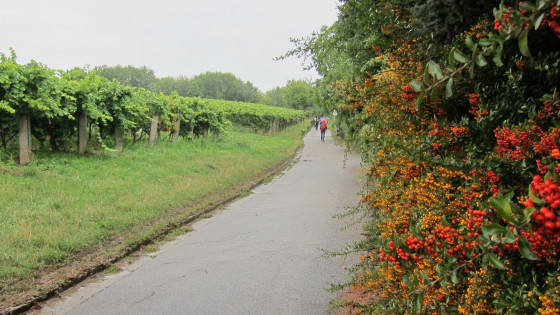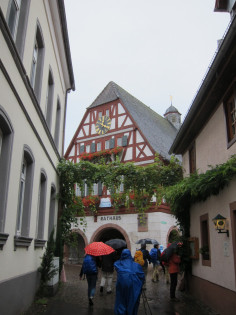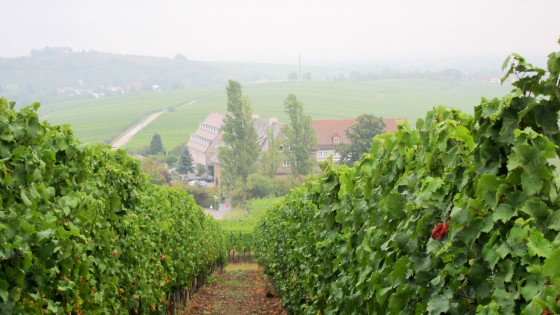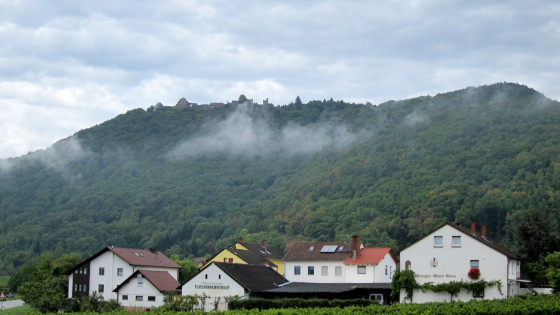The day is marked by the recurring rain, which mostly gently pours down on us. We start our hike in Landau. We covered the distance Herxheim - Landau by bus.
Landau was founded in 1260 as a fortified town to protect the nearby Landeck Castle. As early as 1274, Landau was granted town charter by King Rudolf I of Habsburg, and in 1291 it was given the status of an imperial town. In 1324 Landau was pledged to the Bishop of Speyer. In 1511, the town was redeemed by Emperor Maximilian I and placed under the bailiwick of Haguenau. In 1521 Landau joined the Decapolis, the Alsatian League of Ten Towns, founded in the 14th century)

Hooray, it's not raining right now! At the Stadtring we walk past Café Klimt, built in Art Nouveau style.

We walk through the Königsstrasse to the ...

Holy Cross Parish Church.

There is a modern relief on the entrance portal. It shows the martyred Jesus and the symbols of the four evangelists.
The former monastery church of the Augustinian Hermits was built in the style of a Gothic basilica (15th century). It was destroyed during the war and rebuilt in 1952-1954. The Gothic wall paintings, a larger-than-life Madonna and Child (2nd half of the 17th century) and the medieval cloister from the time of the foundation, which still exists in part, are particularly worth seeing.


After the monks were expelled in 1794, the three-nave church was used as a magazine, concert and exhibition hall. It was not until 1893 that it became a parish church for Catholics again. During the restoration after the war damage, a concrete gallery was installed and the choir room was redesigned.

After the morning attunement in the church, it rains again. We walk to the town hall square.
In the middle of the square is the equestrian statue of Prince Regent Luitpold of Bavaria (erected in 1892).


Old department stores' on the town hall square. Note the bell-ringers on the roof.


Fresco on the old department stores':
The name "Landauer" is said to have originated when King Joseph I travelled from Vienna to Landau in the Palatinate in 1702 to take command of the siege of this then French border
fortress: the sensational event at the time, in which the king covered the distance in 14 daily stages with an entourage of 77 carriages, is said to have permanently linked the new
type of travelling carriage used in the process with the name of Landau.

The modern city fountain depicts Landau's eventful history.
Inscription: Historical moments of the city of Landau, designed by Hubertus von Pilgrim (1991).

Our group leaves the city.

We brave the constant rain ...

... and enter the vineyards. From now on it is constantly uphill and downhill.

Again and again we see wayside crosses, like here in Arzheim.

Colourful shrubs along the path, on the ascent to the small Kalmit mountain

The Kleine Kalmit (from the Latin calvus mons = bare mountain) is the highest elevation of today's hike in the area of the southern Weinstrasse, at 270.5 m. It is the highest peak in the region. The Mater Dolorosa Chapel (Chapel of the Comfort of the Poor) stands on the summit as a landmark visible from afar.

A somewhat bleak view from the small Kalmit into the vineyards.
This is what it looks like in sunny weather:

View from the small Kalmit to the wine village Ilbesheim.

The Ilbesheim town hall from the front ...

... and from the side

Interesting bay window in Ilbesheim

On a ridge we hike to Leinsweiler Hof, pass it and climb up a vineyard. Here is a view back.

We are approaching Eschbach.

The Eschbachers are popularly associated with the "donkey". This nickname probably goes back to those noble owners of the Madenburg who belonged to the knightly and tournament society of those "with the donkey" in the 15th century. They cultivated a pious lifestyle, Christian ideals of virtue and chivalrous courtly manners. The donkey as a sign of society adorned their clothes and was worn on a silver necklace. The citizens of Eschbach living at the foot of the Madenburg were subjects of the "donkey knights". This probably gave rise to the short form "Esel" (donkey), which was given to the people of Eschbach by the inhabitants of the neighbouring villages. As a reminder of this, artistically designed donkey sculptures have been erected throughout the village since 2004.

There had been a chapel in Eschbach since 1405. In 1495, the Antonius Chapel was elevated to the status of a parish church. The patron saint of the old church was St. Anthony, father of monks in Egypt. After the church was rebuilt in 1832, there was a new patrocinium: St. Louis, King of France. The church tower was built in 1962. The last major church renovation was in 1989/90.
The most beautiful thing about the photo is that the sun is shining again!


At the entrance to the church on the left and right are two sandstone figures. On the left, Maria Immaculata. With the moon under her feet, she is crushing the head of a snake.
On the right is a statue of St. John Nepomuk. He is standing on a cloud with an angel at his feet.

After the lunch break in Eschbach, we continue hiking towards Klingenmünster. On the mountain we see the silhouette of Landeck Castle.

We walk through vineyards towards Klingenmünster. On the hill in the distance you can see the buildings of the Palatinate Clinic for Psychiatry and Neurology.

We are greeted before ascending to the clinic.

We walk around the clinic and come to the Nikolauskapelle.
The Romanesque St. Nicholas Chapel is a gem of Staufer sacred architecture. Little is known about its history. Except for the baroque tower dome, it dates from the 12th century.
A look inside shows the church patron St. Nicholas on a mural on the north wall of the choir
On the left, in front of the chapel, you can see two stone doorposts. They belonged to the demolished Magdalenenhof, a residential and farm building that once belonged to the chapel.

Klingenmünster lies ahead
We are already looking forward to our quarters in the former monastery mill.


Marching into the village
Learn more about the
Klingenmünster Monastery








